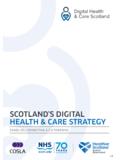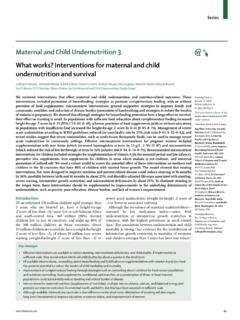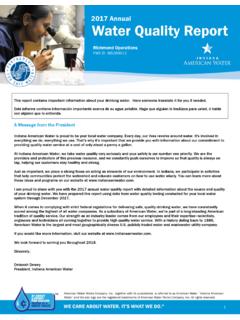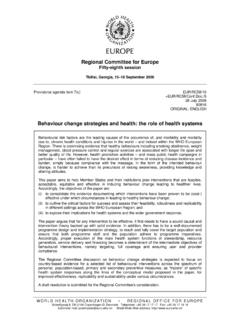Transcription of What works in delivering improved health and …
1 Executive health and safety What works in delivering improved health and safety outcomes A review of the existing evidence Prepared by the Institute for Employment Studies for the health and safety Executive 2008 RR654 Research Report Executive health and safety What works in delivering improved health and safety outcomes A review of the existing evidence Annette Cox BA, MSc, PhD Siobh n O Regan BA, MA Ann Denvir BA, MA Andrea Broughton BA, MA Daniel Pearmain BA, MSc Claire Tyers BSc, MSc Jim Hillage MA, MSc Mantell Building University of Sussex Campus Brighton BN1 9RF This report consists of a literature review on what works in delivering improved health and safety outcomes, using data published since 2002. It is supplemented by an analysis of how HSE uses and generates research-based evidence, drawing on data from interviews conducted with HSE staff. The report identifies knowledge gaps in relation to what works where further research is required, discusses barriers to use and generation of evidence and makes recommendations for how HSE could improve its use of evidence and commissioning of both policy and programme interventions and their respective evaluations.
2 This report and the work it describes were funded by the health and safety Executive (HSE). Its contents, including any opinions and/or conclusions expressed, are those of the authors alone and do not necessarily reflect HSE policy. HSE Books Crown copyright 2008 First published 2008 All rights reserved. No part of this publication may be reproduced, stored in a retrieval system, or transmitted in any form or by any means (electronic, mechanical, photocopying, recording or otherwise) without the prior written permission of the copyright owner. Applications for reproduction should be made in writing to: Licensing Division, Her Majesty s Stationery Office, St Clements House, 2-16 Colegate, Norwich NR3 1BQ or by e-mail to ACKNOWLEGEMENTS We would like to thank all of the HSE staff who gave their time to be interviewed for this project; Alison Higgins, David Riley and Anne-Marie Grey of HSE for their advice and guidance; Sally Wilson for conducting some of the interviews with HSE staff and background research; Professors David Walters, Phil James and Dr Louise Thomson for their work in reviewing the literature; and James Walker-Hebborn for assistance in preparing the final report.
3 Ii Contents Executive Summary (1 page version) v Executive Summary (4 page version) vii 1 Introduction 1 Debates About What works In Improving health And safety 1 HSE Objectives And Targets For The Time Period Of This Review, And This Report s Relationship To Them 1 Project Aims And Objectives 2 Definitions Of Terms 3 Structure Of The Report 5 2 Methods 6 Qualitative Research 6 Literature Review 8 The Nature Of The Evidence Base 10 3 Evidence From The Literature On What works (Part One): Communications Campaigns, Awareness Days, Guidance And Handling Risk 12 Summary 12 Communications Campaigns 13 Guidance 17 safety And health Awareness Days/Roadshows/Workshops 18 Approaches To Handling Risk 19 4 Evidence From The Literature On What works : (Part Two) Standards, health Interventions, Worker Involvement, Incentive/Recognition Schemes, Inspection And Regulation 22 Use Of Standards, Approaches And Other Mechanisms To Improve health And safety 23 Inspection And Enforcement 30 Regulation 32 5 HSE Embedded Knowledge Of What works Compared With Evidence From Literature 36 Summary 36 Staff Views On What works 36 Processes Underpinning Successful Interventions 37 Successful Interventions 39 Difficulties In Identifying What works 41 Basis Of Judgements About What works 42 Do HSE Staff Views And Messages From The Literature Agree On What works ?
4 43 Are There Any Variations In What works According To Size And Sector Of Organisation Or Nature Of Hazard? 44 6 How Does HSE Generate And USE Evidence On What works ? 47 Summary 47 What Sources Of Evidence Do Staff Use? 48 iii Why And How Do Staff Use And Generate Evidence? 49 What Factors Influence Staff Choice Of Different Types Of Evidence? 51 What Do HSE Staff Think Of The Evidence Base? 52 What Problems And Barriers Do HSE Staff Encounter In Generating And Using Evidence? 53 What Are HSE Staff Views On How To Improve The Accessibility Of Evidence? 57 What Strategies Do HSE Staff Suggest For Improving The Quality Of The Evidence Base? 59 7 Conclusions 61 Summary Of Key Findings And Messages About What works 61 How Does The Stock Of Evidence In This Review Compare With That Included In The 2001 Review?
5 62 What Are The Outstanding Knowledge Gaps Identified In This Review?64 Implications Of This Report: What Should The HSE Do To Improve The Evidence Base And HSE Interventions? 65 Appendix 1: Detailed Methodology 69 Sifting And Selection Process 69 Analysis Of Interview Data 69 Appendix 2: Search Terms/Databases Used 72 Databases 72 Search Terms 72 Appendix 3: Sift Proforma 75 Contract Research Reports 75 Academic Articles 75 Appendix 4: Reviewing proforma 76 Article/Report Reference Number: 76 What It Is About? 76 Minimum Criteria 77 Review Findings 78 Proforma For Literature Reviews 81 Article/Report Reference Number: 81 What It Is About? 81 Minimum Criteria 82 Review Findings 83 Appendix 5: Bibliography 86 iv EXECUTIVE SUMMARY (1 PAGE VERSION) What works in delivering improved health and safety outcomes? The following interventions were found to be effective at some level: using face to face communication to educate and inform; new interventions involving Occupational health Service (OHS) provision, especially in relation to prevention and cure of Musculoskeletal Disorders (MSDs); regulation among employers and workers who comply; tools and safety and health Awareness Days (SHADs) are helpful for willing and committed employers; worker involvement techniques such as worker health and safety representatives can be effective in disseminating health and safety messages and generating behavioural change; targeted initiatives can be helpful in enabling setting objectives and encouraging progress towards sectoral health and safety improvements.
6 What are the knowledge gaps? The largest overall knowledge gap identified where further research is required was to identify which levers are most effective in obtaining behavioural change in health and safety practice at an individual and corporate level. This gap has a number of aspects including: which groups are most influential on changing worker behaviour, the power of supply chains, economic and financial incentives and the effects of sanctions including adverse publicity and restorative justice, understanding the roles of industry partnerships and intermediaries, assessing the impact of interventions used in combination with each other, identifying what works in LA enforced sectors and/or those with migrant workers, understanding work process design and identifying the effects of targeting interventions.
7 How could HSE improve its use and generation of evidence? A number of barriers to better use and generation of evidence in HSE were identified. These included time pressures, political pressures, knowledge management problems and use of analysts. The suggestions put forward by HSE staff for making evidence accessible were making more use of workshops/seminars; written summaries; electronic media. Many also emphasised that proactive evidence supply was as important as format. Interviewees made very little use of existing documented evidence in the form of commissioned research reports and externally published evidence and relied on statistics and their own networks for evidence. HSE could improve how it uses evidence by: agreeing on what constitutes good enough evidence, implementing multiple channels for dissemination and access to evidence eg flexible searches of HSE databases, a web-based set of resources on evidence-based policy making and case studies of good practice, internal seminars to disseminate tacit knowledge, provide short email digests and summaries targeted by topic/sector/programme.
8 HSE could improve how it generates evidence by introducing a rigorous commissioning process for interventions and research, building on the Science Planning Process. This would require: consideration of a broader evidence base before and during commissioning of research, design, delivery and evaluation of policy interventions; developing closer working between analysts and internal policy clients; making greater use of longitudinal independent checks on behavioural change in evaluations; potentially undertaking fewer, v more focussed evaluations, for example restricting evaluations to interventions where full ex-ante appraisal of intervention choices has been made and a quantifiable impact on outcomes is anticipated; undertaking more small scale studies, secondary reviews or meta-analyses of what works .
9 Vi EXECUTIVE SUMMARY (4 PAGE VERSION) The aim of this report review is to draw together and update knowledge about what works in delivering improved health and safety outcomes and to investigate what role research-based evidence plays in shaping the design and delivery of HSE s programmes and how the use and generation of evidence could be improved . It involved an iterative review process of published research, including reports commissioned by HSE and relevant studies identified in wider academic literature, and 31 interviews with HSE staff. Key findings on what works to improve health and safety outcomes Inspection and awareness-raising face-to-face events play an important role in large scale multi-method campaign activities. Partners and intermediaries can play an important role. Print-based messages alone have some effectiveness in raising awareness of risks but are weak in converting awareness to behavioural change.
10 Multi-method campaigns appear to be more effective as there is evidence of behaviour change in a small proportion of employers. New interventions are working Occupational health Service (OHS) provision and interventions to prevent and cure Musculoskeletal Disorders (MSDs) deliver improved health and safety outcomes. Regulation provokes improved health and safety practice among those who are willing to comply but invisible risks such as workplace stress are harder to police through inspection and may therefore be less amenable to regulation. Tools and safety and health Awareness Days (SHADs) are helpful for willing and committed employers. Worker involvement techniques such as worker health and safety representatives can be effective in disseminating health and safety messages and generating behavioural change. targeted initiatives can be helpful in enabling setting objectives and encouraging progress towards sectoral health and safety improvements by building commitment among organisations.














